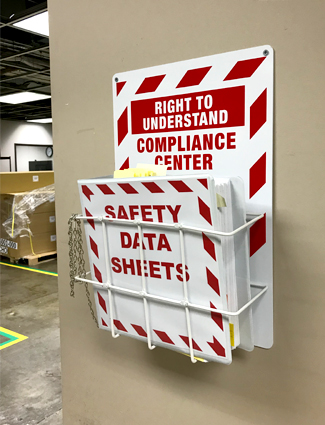Avert Chemical Safety Program Failures

Chemical safety seems to be a complex problem for workplaces to master. Each year, HazCom violations are among OSHA's top 10 most common violations. Every workplace handles chemicals in various quantities and for different applications and tasks. Also, each of those chemicals may have unique hazards. Maintaining a safe workplace requires a thorough understanding of the chemical hazards present, as well as a solid hazard communication program that follows OSHA's HazCom requirements.
Lurking Hazards
Recently, chemicals sitting in a warehouse without appropriate safety measures caused a deadly explosion. While this event caused massive devastation, there are thousands of similar unsafe chemical storage situations each year that could be as dangerous and deadly. Some catch attention and are corrected, while others remain accidents waiting to happen.
"Employers are required to ensure employees who work with hazardous chemicals know the dangers associated with those chemicals and provide them with readily available facilities to minimize injuries," OSHA representative Condell Eastmond said in March after a workplace chemical exposure in Florida.
OSHA's HazCom rule focuses on communication about the hazards and precautions associated with a chemical. But in 2019, Hazard Communication was listed at No. 2 on OSHA's Top 10, with 3,671 violations - the same spot it has held for several years. When breaking down those violations, they are the result of workplaces failing to:
- Develop and maintain a written program
- Maintain employee training
- Label hazardous chemical containers
- Keep Safety Data Sheets available in the workplace
Ensure Chemical Safety
When establishing or updating a written chemical safety program, workplaces should start with a risk assessment. This helps identify and control chemical hazards. From that assessment, workplaces move to risk management and create a checklist of tasks, such as the assignment of applicable controls. Workplaces should also review their assessments when there is a change in the work process, equipment, or operating methods.
After an assessment, any chemical hazards must be communicated to the affected employees. A key part of this mandatory HazCom program is maintaining safety labels. Accurate labels and signs are key components of hazard prevention. These visual tools give workers the information they need to do their job correctly, prevent injuries, and to keep the workplace secure. Labels should not be altered, removed, or defaced, and must provide certain minimum information.
 Emergency response is another important element of chemical safety planning. Many common industrial chemicals are flammable, so ensure fire and other emergency equipment are adequate. Establish and maintain fire exit routes in case there is an emergency. Your facility may also need emergency showers or other equipment in case of worker contact with chemicals. Eyewash stations should be clean and operable. These types of stations should be easy to access.
Emergency response is another important element of chemical safety planning. Many common industrial chemicals are flammable, so ensure fire and other emergency equipment are adequate. Establish and maintain fire exit routes in case there is an emergency. Your facility may also need emergency showers or other equipment in case of worker contact with chemicals. Eyewash stations should be clean and operable. These types of stations should be easy to access.
Chemical safety can also benefit from other business improvement methods, such as 5S. When a workplace is running efficiently, there is less of a chance for unused chemicals to sit around, taking up space, and tying up capital. Using 5S, workplaces can streamline activities from shipping and receiving to asset management and hazard awareness. 5S also establishes a structure to ensure everything is kept in its place and providing the greatest benefit to the facility.
Lastly, all of the above measures for establishing a safety plan for chemicals is no good if workers do not receive training. Train all workers, from forklift drivers to maintenance, to work safely around the chemicals in a facility. Make sure they understand the facility's chemical signs, labels, and floor marking for safety and efficiency.
Improve safety around hazardous chemicals and meet OSHA's HazCom 2012 requirements using our free HazCom Quick Start Guide.
Related Resources

Tips for Better Chemical Safety Management
Workplace chemical safety is all about understanding the risks and following proper protocol. Train and ...
Read
Hazardous Chemicals Overview
In the eyes of OSHA, hazardous materials run the gamut from household cleaners to deadly gasses. Effects can ...
Read
HazCom Training
OSHA's HazCom rules, sometimes called the Hazard Communication Standard or HazCom 2012, cover requirements ...
Read.png)





